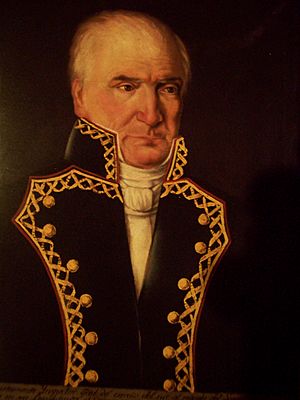Carlos María de Bustamante facts for kids
Quick facts for kids
Carlos María de Bustamante Merecilla
|
|
|---|---|

Portrait of Bustamante, circa 1836. Unknown artist.
|
|
| Deputy of the Province of Mexico | |
| In office 1813–1815 |
|
| Personal details | |
| Born | 4 November 1774 Oaxaca, New Spain |
| Died | 29 September 1848 Mexico City, Mexico |
| Occupation | Statesman, historian, journalist |
Carlos María de Bustamante Merecilla (born November 4, 1774 – died September 29, 1848) was an important Mexican leader. He was a statesman, historian, and journalist. He played a big role in helping Mexico become independent. He supported independence both before and during the Mexican War of Independence.
After Mexico gained independence in 1821, Bustamante was involved in every Mexican congress until he died in 1848. He helped create a sense of Mexican pride and identity. His historical writings helped start a tradition of studying Mexico's past. This included looking at the history of Indigenous peoples and their lives during the time Spain ruled Mexico. His writings helped turn the desire for independence into a strong movement for freedom.
Biography
Carlos María de Bustamante was born in Oaxaca on November 4, 1774. In 1796, he began studying law. He soon joined the movement that wanted Mexico to be independent from Spain.
In 1805, when Spain still ruled Mexico, he started a newspaper called Diario de México. In this newspaper, he shared ideas about freedom and independence. Because of his strong opinions, he was put in jail many times. The War of Mexican Independence finally began in 1810. Later, a new Spanish law gave Mexico some freedom. Bustamante then started another newspaper, El Juguetillo. He kept pushing for Mexico to be completely independent.
In 1813, José María Morelos y Pavón, a leader of the Mexican rebels, made Bustamante the editor of the independence newspaper Correo Americano del Sur. That same year, Morelos organized the Congress of Chilpancingo. Bustamante was a representative there. He also wrote Morelos's opening speech for the congress. This speech said that the rebels would free Mexicans from the "chains of serfdom" that began in 1521. The congress then wrote the Constitution of Apatzingán. This was Mexico's first constitution, creating an independent, republican government. However, it was never put into action because the war started to go against Morelos.
When Mexico finally became independent in 1821, Bustamante was chosen as a representative from Oaxaca. He was against Agustín de Iturbide becoming the emperor of the new First Mexican Empire. Bustamante was one of the representatives Iturbide put in jail. But Iturbide's empire did not last long, less than a year. Bustamante later helped write the 1824 Constitution of Mexico.
In 1846, people were worried that President Mariano Paredes wanted to bring a king to Mexico. Bustamante started publishing a newsletter called Mexico no quiere rey y menos a un extranjero. This means "Mexico doesn't want a king, let alone a foreign one."
The Mexican–American War made him very sad. He died shortly after the war ended in 1848.
His Writings and Books
Carlos María de Bustamante was a very important Mexican historian. He was always involved in Mexican politics. He held many important jobs during difficult times for Mexico. He published many historical works from the colonial period. These works were often old manuscripts that were almost forgotten.
One of his most important contributions was publishing Historia general de las cosas de Nueva España. This book was written by Fray Bernardino de Sahagún in the 1500s. Publishing it was a great help to historical research.
Besides Sahagún's work, Bustamante also printed other important historical texts. He published the chronicle of Francisco López de Gómara. He also published the work of Veytia on Tezcuco. He printed the writings of Gama about two large Mexican sculptures. He found the manuscript of an exiled Mexican Jesuit named Andrés Cavo. This was Historia civil y política de México (Civil and Political History of Mexico). Bustamante published it with a large appendix. He titled it Los tres siglos de México bajo el gobierno español hasta la entrada del Ejécito Trigarante. This means "Three Centuries of Mexico Under the Spanish Government until the entry of the Army of the Three Guarantees." The first edition came out in Mexico City between 1836 and 1838.
Bustamante also published parts of Mariano Veytia's Historia antigua de México. This book was based on manuscripts collected by Lorenzo Boturini de Benaducci. His own autobiography, Lo que se dice, y lo que se hace, 1833, is also valuable. It gives us a look into the history of his time.
Some of his other writings include:
- Galería de antiguos príncipes mexicanos (1821)
- Crónica mexicana, Teoamoxtli (1822)
- Mañanas de la alameda de México (2 volumes, 1835-36)
- Cuadro histórico de la revolución de la América Mejicana
See also
 In Spanish: Carlos María de Bustamante para niños
In Spanish: Carlos María de Bustamante para niños

